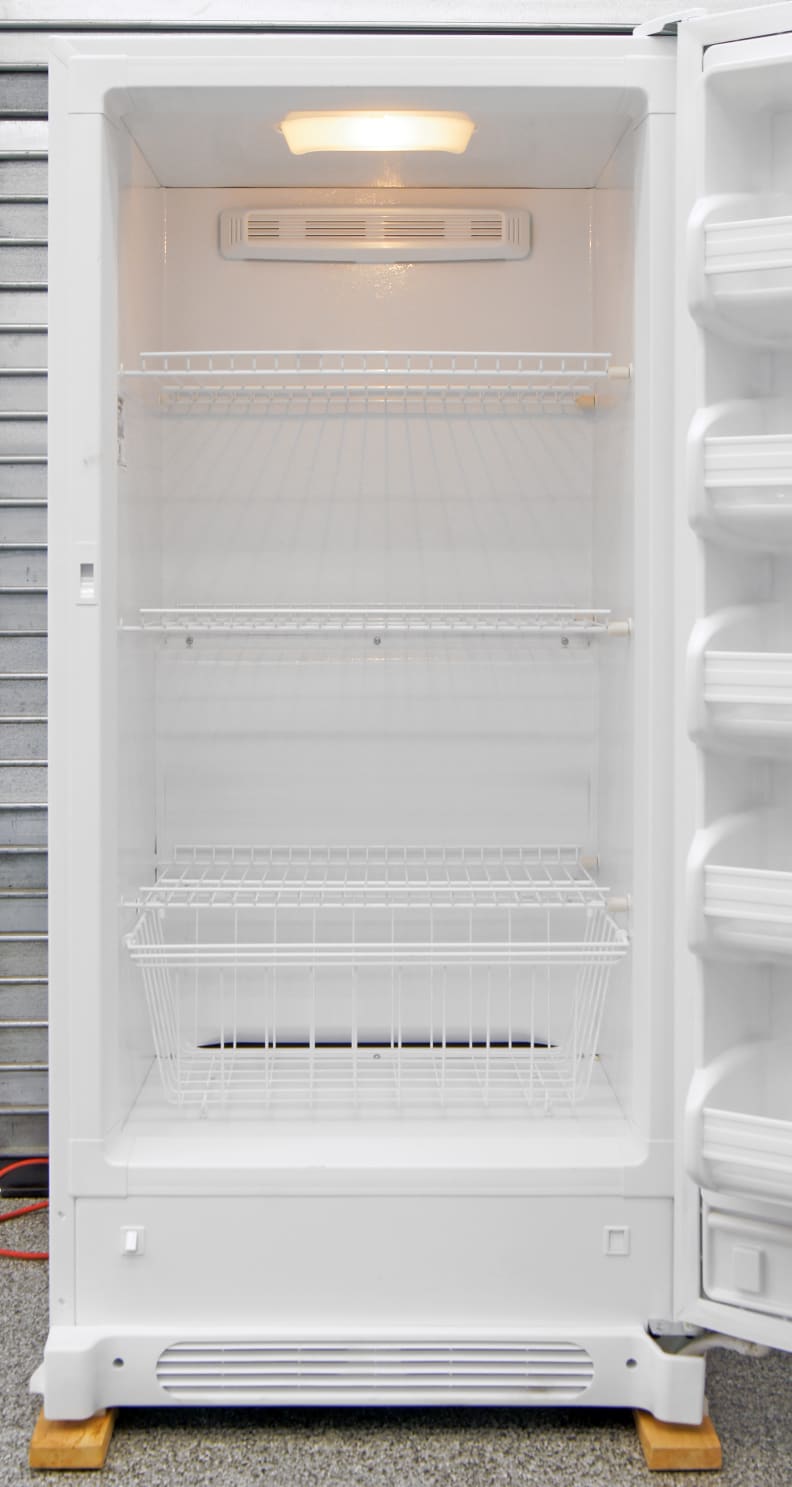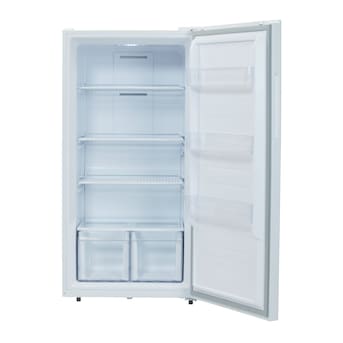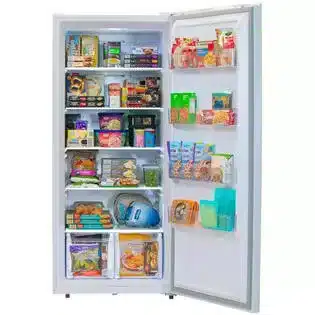If you have a Kenmore refrigerator with a freezer compartment, you may notice some frost or ice buildup on the walls, shelves or food items over time. This can reduce the cooling efficiency and storage space of your freezer, and may even affect the quality and taste of your food. That’s why it’s important to defrost your freezer regularly to remove any excess frost or ice and maintain its optimal performance.
To defrost only the freezer of your Kenmore refrigerator, you need to turn off the freezer temperature control knob to 0 or Off and unplug the refrigerator. Then, remove all the items from the freezer and store them in a cooler or another freezer. Next, place some towels or pans under the freezer to catch any water drips.
Wait for several hours until all the frost or ice melts completely. Finally, wipe the freezer dry and plug in the refrigerator. Turn on the freezer temperature control knob to your desired setting and return the items to the freezer.
How to Know When Your Freezer Needs Defrosting
Most Kenmore refrigerators have an automatic defrost system that prevents any frost or ice buildup in the freezer. However, sometimes this system may not work properly due to various reasons, such as faulty parts, power outages, door seal problems or frequent door openings. In that case, you may need to defrost your freezer manually.
Here are some signs that your freezer needs defrosting:
- Your freezer is not cold enough or not freezing at all. If your freezer is running but not cooling properly, it may be due to excessive frost or ice buildup that blocks the airflow and reduces the heat transfer. You can use a thermometer to check the temperature inside your freezer. It should be between 0°F and 10°F for optimal food storage.
- Your freezer is making loud or unusual noises. If your freezer is making hissing, bubbling or gurgling sounds, it may indicate a problem with the defrost system or the refrigerant system. You may also hear a clicking sound when the compressor tries to start but fails due to low pressure caused by frost or ice buildup.
- Your freezer has frost or ice buildup on the walls, shelves or food items. If your freezer has visible frost or ice buildup on any surface, it means that there is too much moisture in the freezer that freezes on contact with the cold air. This can reduce the storage space and make it harder to access or remove your food items.
If you notice any of these signs, you should defrost your freezer as soon as possible to prevent further damage and restore its normal function.

How to Defrost Only The Freezer Of Your Kenmore Refrigerator
Defrosting only the freezer of your Kenmore refrigerator is a simple but time-consuming process that requires some preparation and patience. Here are some steps that you need to follow:
- Turn off and unplug your refrigerator. The first step to defrosting your freezer is to turn off the power supply to your refrigerator. You can do this by turning off the freezer temperature control knob to 0 or Off and unplugging the refrigerator from the wall outlet. If you cannot reach the power cord, you can also turn off the circuit breaker that controls your refrigerator.
- Remove all the items from the freezer. The next step is to remove all the items from your freezer and store them in a safe place. You can either use another freezer if you have one, or a cooler with ice packs if you don’t. You can also consume, donate or discard any food items that are expired, spoiled or unwanted.
- Place some towels or pans under the freezer. The third step is to place some towels or pans under your freezer to catch any water drips that may occur during defrosting. You can also use newspapers, rags or plastic sheets to protect your floor from any spills or leaks.
- Wait for several hours until all the frost or ice melts completely. The fourth step is to wait for several hours until all the frost or ice in your freezer melts completely. Depending on how much frost or ice there is, this may take anywhere from 4 to 24 hours. You can speed up this process by using a fan, a hair dryer or a bowl of hot water to circulate warm air around your freezer. However, do not use any sharp objects, such as knives, scrapers or hammers, to chip away at the frost or ice, as this may damage your freezer walls or coils.
- Wipe the freezer dry and plug in the refrigerator. The final step is to wipe your freezer dry with a cloth or a paper towel after all the frost or ice has melted. Make sure there is no water left in your freezer before plugging in your refrigerator. Then, turn on the freezer temperature control knob to your desired setting and wait for the freezer to reach the proper temperature.
- Return the items to the freezer. Once your freezer is cold enough, you can return the items to your freezer. Make sure you organize them properly and leave some space between them for better airflow and cooling. You can also label and date your food items to keep track of their freshness and avoid any waste.

What To Do After Defrosting Your Freezer
After defrosting your freezer, you may want to do some additional steps to ensure that your freezer works well and stays frost-free for a long time. Here are some tips that you can follow:
- Check and replace the door seal. The door seal is the rubber gasket that seals the gap between the door and the freezer. It prevents warm air from entering and cold air from escaping your freezer. If the door seal is damaged, worn out or dirty, it may cause frost or ice buildup in your freezer. You can check the door seal by closing the door on a dollar bill and pulling it out. If the bill slides out easily, it means that the door seal is loose and needs to be replaced. You can also clean the door seal with a mild detergent and a soft cloth to remove any dirt or debris that may affect its function.
- Adjust the temperature and humidity settings. The temperature and humidity settings of your refrigerator and freezer can affect the amount of frost or ice buildup in your freezer. You can adjust these settings according to your preferences and needs, but generally, you should keep your refrigerator between 37°F and 40°F and your freezer between 0°F and 10°F for optimal food storage. You should also avoid setting your humidity level too high, as this may increase the moisture in your freezer and cause more frost or ice buildup.
- Avoid frequent or prolonged door openings. One of the main causes of frost or ice buildup in your freezer is frequent or prolonged door openings. Every time you open your freezer door, you let warm air in and cold air out, which creates condensation that freezes on contact with the cold surfaces. To prevent this, you should avoid opening your freezer door too often or too long, and only open it when you need to access or store something. You should also close your freezer door firmly and make sure it is not blocked by any food items or containers.

FAQs About Defrosting Only The Freezer Of Your Kenmore Refrigerator
Here are some common questions and answers about defrosting only the freezer of your Kenmore refrigerator:
- How often do I need to defrost my freezer? You need to defrost your freezer whenever you notice any signs of frost or ice buildup in your freezer, such as reduced cooling efficiency, loud noises, frosty walls or food items. Depending on how often you use your freezer and how well you maintain it, this may vary from once a month to once a year.
- What are the benefits of defrosting my freezer regularly? Defrosting your freezer regularly has many benefits, such as:
- Improving the cooling efficiency and performance of your freezer
- Increasing the storage space and accessibility of your food items
- Preserving the quality and taste of your food items
- Saving energy and money by reducing the power consumption of your refrigerator
- Preventing any damage or problems with your freezer components
- What are some alternatives to defrosting my freezer manually? If defrosting your freezer manually is too tedious or inconvenient for you, you may want to consider some alternatives, such as:
- Buying a new refrigerator with a frost-free feature that prevents any frost or ice buildup in your freezer automatically
- Hiring a professional technician who can defrost your freezer for you safely and correctly
- Using a commercial defrost spray that can melt away any frost or ice in your freezer quickly and easily




